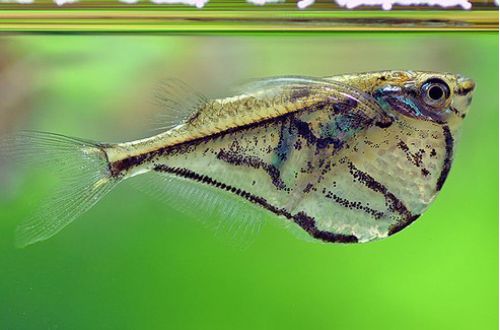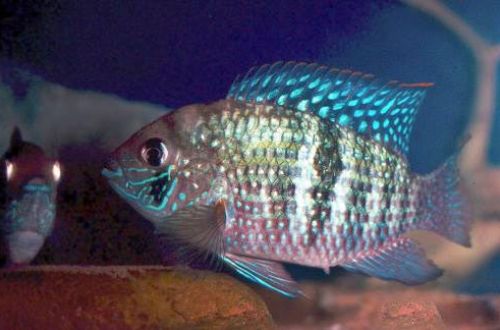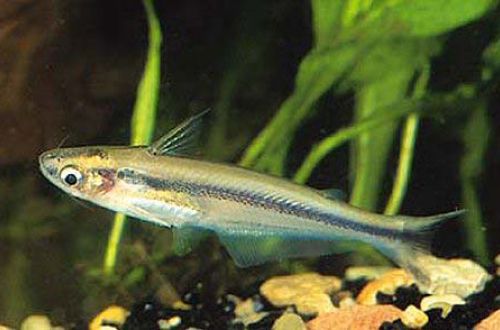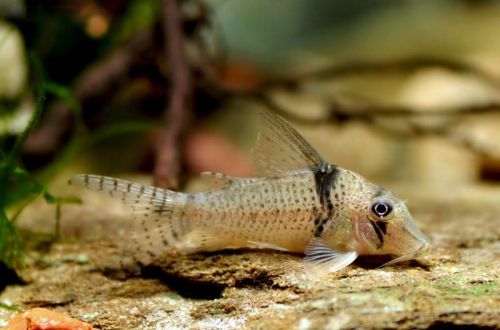
carnegiella
Marble hatchetfish or Carnegiella, scientific name Carnegiella strigata, belongs to the Gasteropelecidae family, the name of the family translates as “axe-shaped belly”, which is easily visible in the appearance of the fish. An amazing representative of the haracins, differs not only in the unusual shape of the body, but also in behavior. Hatchet fish can jump out of the water after insects flying by, while helping themselves during the flight with their pectoral fins, like wings.

Contents
Habitat
The fish is distributed throughout the Amazon River basin (South America), found in countries such as Colombia, Suriname, Peru and Brazil. They prefer forest streams and channels with a lot of vegetation. They live in flocks, spending most of their time at the surface of the water, feeding on crustaceans and insects.
Description
The first thing that attracts attention is the shape, the fish looks like a miniature ax or an ax with a large blade. The body is flattened from the sides and elongated, the abdomen protrudes forward. The pectoral fins are perpendicular to the body, when they are set aside, they resemble wings. The mouth is located at the top of the head for feeding from the surface. The coloration is light with irregularly shaped black stripes, similar to a marble pattern.
Food
Carnivorous species, requires the presence of meat products, such as bloodworms. Although in most sources Carnegieella is presented as an omnivore, however, she is not able to survive on exclusively dry food. The optimal diet is a special dry food containing freeze-dried meat products (see the composition before buying), or regular food with the obligatory addition of protein foods (mosquito larvae, bloodworms, daphnia, etc.). The food must be floating, what falls to the bottom will not be eaten.
Maintenance and care
Fish require high quality water. It is recommended to use a high capacity filter canister. Each piece of equipment is marked with a minimum tank size for which it is intended, so please purchase a filter for a tank larger than yours. Excessive performance will avoid situations when, after prolonged operation, the filter becomes clogged and the water quality gradually decreases. Since fish prefer acidic water, peat-based media can be used as a filter material. Other required equipment: aerator, heater, lighting system.
Floating plants are welcome in the design. However, they should not cover the entire surface area of the water, free areas are necessary for feeding. The substrate is sandy, decorated to your taste, for fish this area of uXNUMXbuXNUMXbthe aquarium is not of interest.
Social behavior
Flocking species, content in a group of at least 6 individuals. Marble hatchetfish are peaceful, shy, preferring a community of related species (eg Common Hatchetfish) or other small calm fish from Tetras or catfish.
Sexual differences
The differences between the sexes are weak, the female is only slightly fatter than the male when viewed from above, however, during spawning, the abdomen of the females becomes more than noticeable.
Breeding / breeding
Breeding Marble hatchet fish requires some effort and a separate tank. A spawning aquarium of at least 40 liters so that a couple of fish can feel comfortable. The composition of the water at the first stage should completely repeat the composition of the general aquarium. The equipment consists of a canister filter (high performance is no longer required), a heater, an aerator, a low power lighting system. In the design, floating plants are used, as well as rooted ones with wide or medium leaves. The soil is sandy, any decor elements, although you can just as well do without them.
Several females and males are moved to a separate tank. Gradually, water is brought to values of 5.5–6.5 dGH. You can add a few dry leaves and a rag bag with peat to the aquarium, it is advisable to purchase it ready-made in pet stores than to process it yourself. The water will become dark, but without the suspension that the equipment will filter out. Lighting should be half the power that is used in the main aquarium. Feed flying insects (fruit flies, mosquitoes or their larvae, bloodworms). After some time, similar environmental conditions should encourage spawning.
The female lays her eggs in clusters on the leaves of plants or their exposed roots, and the male fertilizes them. After that, the parents are returned to the community tank so that they do not eat their own eggs. The fry appear every other day and begin to swim freely on the fifth day. Feed with microfood, finely ground flakes, granules, serve Artemia nauplii.
Diseases
During acclimatization in a new aquarium, skin diseases often develop, and this also happens if the quality of the water decreases. Otherwise, the fish feels great in a balanced aquarium and, as a rule, there are no health problems. For more information on symptoms and treatments, see the Aquarium Fish Diseases section.





